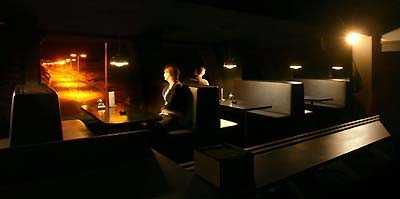Three exhibitions
dal 23/1/2004 al 11/4/2004
Segnalato da
23/1/2004
Three exhibitions
Gemeentemuseum, Den Haag
Hans Op de Beeck, Armen Eloyan and From the Dark Room with: Michael Ackerman, Dirk Braeckman and Awoiska van der Molen

Hans Op de Beeck
In the Meantime, ...
''Location (5)'', Hans Op de Beeck's new and largest ever three-dimensional installation to date, can be seen at the GEM Museum of Contemporary Art at The Hague until 11 April 2004. Working together with students from the Hague's Royal Academy of Art, a number of experts, technical assistants and volunteers, Op de Beeck has created a monochrome replica of a motorway café, measuring 4 x 11 x 22 meter.
Visitors are able to enter the café, to sit down at the typical dinner tables and watch the sinister, nocturnal landscape, which is revealed through the glass windowpanes. In addition to the installation, the museum is also giving a brief overview of the artist's oeuvre. Hans Op de Beeck (1969, Turnhout) is making drawings, videos, sculptures and installations that manifest his concern with the anonymity, alienation and even the absurdity of modern live.
Armen Eloyan
Welcome home where we are
Armen Eloyan (Yerevan, Armenia, 1966) comes from Armenia but now lives and works in The Hague. He produces watercolours and oil paintings of disturbing subjects. Out of his thick layers of paint emerge landscapes, masochistic male figures and torturers, which are as seductive as they appalling. In his work, historical events alternate with incidents from his own past. In order to do full justice to Eloyan's sadistic universe, it has been decided to recreate his studio temporarily in the GEM. For three whole months, the artist will paint, eat and sleep there, in the midst of his work to the accompaniment of his favourite ear-splitting music. The recent work that Eloyan will be showing at the GEM is dominated by a fascination with extreme rightwing political movements and religious fundamentalism.
From the Dark Room
Work by Michael Ackerman, Dirk Braeckman and Awoiska van der Molen
The Dark Room is an exhibition of work by three contemporary photographers, each of whom is – in his or her own way – engaged in an exploration of the portrait genre. Apart from the contrasts and confrontations revealed by the presentation, one thing will be immediately apparent to visitors: all three photographers work in classic black and white and they cherish the traditional craft of hand-developing and printing.
In the case of American Michael Ackerman, the result is extraordinarily dynamic and expressive, while Belgian Dirk Braeckman aims to create images that express detachment and restraint, and Dutchwoman Awoiska van der Molen produces evenly lit photographs that are intentionally understated and serene. All three share an inclination towards simplicity and bleakness, as regards both subjects and presentation. With their pure, monochrome photographs, these photographers seem to be making a stand against the current fashion for hyper-realistic colour photography.
In the late ‘90s, Michael Ackerman (Tel Aviv, 1967) achieved an international reputation for his unpolished images of inner-city squalor in New York, Katowice and Naples. He uses his 35 mm camera casually, as if it were a film camera continuously recording the urban scene. The movement and lack of focus in Ackerman's photos (often introduced retrospectively in the darkroom) produce a disturbing effect echoing the often depressing character of inner-city life. Ackerman's contribution to the exhibition in The Hague will consist of a large tableau produced in 2003 and composed of 42 portraits of solitary and desperate men encountered by the photographer in the course of his peregrinations around various cities. Ackerman has photographed his subjects secretly and at close quarters, sitting at the bar and shooting from the hip.
The works by Dirk Braeckman (Ghent, 1958) date from the 1980s and were acquired by the Gemeentemuseum Den Haag in 2003. Braeckman's oeuvre displays a constant evolution over time: there is a direct linear relationship between his early portraits of naked figures in vague interiors and his current images of deserted buildings. The harshness of Braeckman's photographs – all unflattering poses and bouncing flash – is cancelled out by his darkroom technique: he gives his images a velvety softness by printing them with a matt finish in many shades of grey. This gives the pictures a certain delicacy without diminishing their motionless and enigmatic quality.
Rotterdam photographer Awoiska van der Molen (Groningen, 1972) is rapidly making a name for herself with her tranquil black-and-white portraits of carefully selected anonymous individuals who possess and exude a natural sense of repose. In her subjects, Van der Molen looks for this quality of timeless serenity. Through her choice of models, setting, natural lighting and the achievement of a ‘dry' tonality in her prints, she has managed to create a series of portraits which suggest a challenging sense of timelessness.
GEM & Hague Museum of Photography
GEM is a new museum of contemporary art set up to show work by artists from The Hague, the Netherlands and the world at large side by side. It will feature a wide variety of disciplines: video and other installations, painting and sculpture, multimedia, performance art, film, photography, drawings, digital art, design, etc. In addition to the exhibitions, there will be a programme of activities including talks, discussions, performances, film shows and book presentations.
Image: Hans Op de Beeck
GEM, Museum of Contemporary Art, The Hague
Stadhouderslaan 43 2517 HV Den Haag



